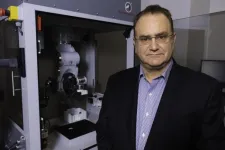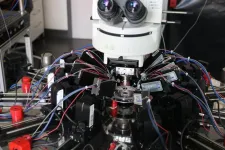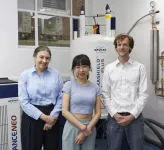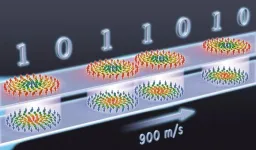(Press-News.org) HOUSTON – (April 18, 2024) – Bioengineers at Rice University have been awarded $1.4 million as part of a multi-center consortium funded by the Advanced Research Projects Agency for Health (ARPA-H) to develop strategies for reversing the effects of osteoarthritis.
“We’re thrilled to be a part of this collaborative effort to tackle one of the most challenging degenerative joint diseases and develop, test and commercialize solutions for patients,” said Antonios Mikos, the Louis Calder Professor of Chemical Engineering and professor of bioengineering and materials science and nanoengineering.
APRA-H is part of the National Institutes of Health, and the osteoarthritis funding is administered through its National Initiative for Transforming Research Outcomes program. Mikos’ collaborator on the project is Vasiliki Kolliopoulos, a Rice Academy Postdoctoral Fellow in his lab.
According to the Centers for Disease Control and Prevention, 32.5 million people in the U.S. and 500 million globally suffer from the degenerative joint disease known as osteoarthritis.
The consortium, named Orchestrating Multifaceted Engineering for Growing Artificial Joints (OMEGA), is led by Case Western Reserve University in Cleveland. Overall, OMEGA has been awarded $47.7 million for two phases of research spanning five years.
Various research teams within OMEGA will investigate and integrate perspectives including biomechanics, regenerative medicine, computational modeling and clinical practice to develop equitable interventions targeting osteoarthritis in patients. As part of the program, 40 patients within five years will have knee replacements with “live joints,” or biocompatible bone and cartilage grown from human cells that can restore natural function. The goal is to scale up the technology to make treatment available to patients commercially.
“Most of us know someone who has this degenerative joint disease. The potential treatment outcomes from this research could improve the quality of life for millions suffering with osteoarthritis,” said Mikos, director of the Biomaterials Lab, the Center for Excellence in Tissue Engineering and the J.W. Cox Laboratory for Biomedical Engineering at Rice.
The Biomaterials Lab will provide state-of-the-art equipment and resources for the design and fabrication of 3D-printed scaffolds, crucial for the creation of live joints. Uday Jammalamadaka, manager of the Biomaterials Lab, will also contribute to the project.
Current treatment for osteoarthritis offers neither a permanent cure nor solutions without negative effects. In 2020, 1.5 million Americans underwent hip and knee replacements, a number expected to increase by 11% annually to about 5 million procedures by 2040 as the aging population increases and incidence of obesity grows.
Prosthetic implants presently have a short- to medium-term life cycle, lasting about 20 years. Additional surgery is required as the implants wear out.
Other members of the consortium include Colorado State University, Ohio State University, Washington State University, the Boston biotech firm Sapphiros AI Bio, University Hospitals Medical Center of Cleveland, the Louis Stokes Cleveland VA Medical Center and Massachusetts General Hospital.
⎯ by Patrick Kurp, science writer at the Rice University George R. Brown School of Engineering
-30-
This news release can be found online at news.rice.edu.
Follow Rice News and Media Relations via Twitter @RiceUNews.
Image downloads:
https://news-network.rice.edu/news/files/2024/04/240119_Antonios-Mikos_Gustavo-102368-a20a4d9a4298ecce.jpg
CAPTION: Antonios Mikos is the Louis Calder Professor of Chemical Engineering, professor of bioengineering and materials science and nanoengineering and director of the Biomaterials Lab, the Center for Excellence in Tissue Engineering and the J.W. Cox Laboratory for Biomedical Engineering at Rice University. (Photo by Gustavo Raskosky/Rice University)
About Rice:
Located on a 300-acre forested campus in Houston, Rice University is consistently ranked among the nation’s top 20 universities by U.S. News & World Report. Rice has highly respected schools of architecture, business, continuing studies, engineering, humanities, music, natural sciences and social sciences and is home to the Baker Institute for Public Policy. With 4,574 undergraduates and 3,982 graduate students, Rice’s undergraduate student-to-faculty ratio is just under 6-to-1. Its residential college system builds close-knit communities and lifelong friendships, just one reason why Rice is ranked No. 1 for lots of race/class interaction, No. 2 for best-run colleges and No. 12 for quality of life by the Princeton Review. Rice is also rated as a best value among private universities by Kiplinger’s Personal Finance.
END
Rice bioengineers win $1.4 million ARPA-H grant for osteoarthritis research
Antonios Mikos and team to tackle degenerative joint disease, develop ‘live’ joints
2024-04-18
ELSE PRESS RELEASES FROM THIS DATE:
COVID-19 booster immunity lasts much longer than primary series alone, York University-led study shows
2024-04-18
April 18, 2024, TORONTO – Thinking about getting a spring-time booster shot? A new study coming out of York University’s Centre for Disease Modelling in the Faculty of Science shows that immunity after a COVID-19 booster lasts much longer than the primary series alone. These findings are among other, sometimes “unintuitive,” revelations of how factors like age, sex and comorbidities do and don’t affect immune response.
The study’s authors – York Post Doctoral researchers Chapin ...
Bentham Science joins United2Act
2024-04-18
Bentham Science Publishers is now a signatory organization of United2Act's consensus statement on paper mills.
We are committed to upholding the highest standards of research integrity in academic and scientific publishing. Part of the effort to uphold integrity in scientific publishing includes preventing publication from fraudulent 'paper mills' which negatively impact the credibility of research. We fully support the COPE position statement on this critical issue.
The intrusion of fraudulent papers into the publication record not only undermines public trust in research but also poses significant risks to ...
When thoughts flow in one direction
2024-04-18
Contrary to previous assumptions, nerve cells in the human neocortex are wired differently than in mice. Those are the findings of a new study conducted by Charité – Universitätsmedizin Berlin and published in the journal Science.* The study found that human neurons communicate in one direction, while in mice, signals tend to flow in loops. This increases the efficiency and capacity of the human brain to process information. These discoveries could further the development of artificial neural networks.
The neocortex, a critical structure for human intelligence, is less than five millimeters thick. There, in the outermost layer of the brain, 20 billion neurons process ...
Scientists identify airway cells that sense aspirated water and acid reflux
2024-04-18
Scientists Identify Airway Cells That Sense Aspirated Water and Acid Reflux
The new work by UCSF researchers could lead to interventions to prevent pneumonia or treat certain types of chronic cough.
When a mouthful of water goes down the wrong pipe – heading toward a healthy person’s lungs instead of their gut – they start coughing uncontrollably. That’s because their upper airway senses the water and quickly signals the brain. The same coughing reflex is set off in people with acid reflux, when acid from the stomach reaches the throat.
Now, UC San Francisco scientists have identified the rare type of cell responsible ...
China’s major cities show considerable subsidence from human activities
2024-04-18
The land under nearly half of China’s major cities is undergoing moderate to severe subsidence, affecting roughly one-third of the nation’s urban population, according to a systematic national-scale satellite assessment. The findings suggest that within the next century, 22 to 26% of China’s coastal land will have a relative elevation lower than sea level, putting hundreds of millions of people at elevated risk of flooding due to sea-level rise. Over the last several decades, China has experienced one of the most rapid and extensive urban expansions in human history. This massive wave of urbanization may be threatened ...
Drugs of abuse alter neuronal signaling to reprioritize use over innate needs
2024-04-18
Drugs of abuse, like cocaine and opioids, alter neuronal signaling in the nucleus accumbens (NAc), hijacking a key brain reward system involved with the fulfillment of innate needs for survival, according to a new study in mice. The findings provide mechanistic insights into the intensification of drug-seeking behaviors in substance use disorders. Persistent drug use is accompanied by a profound reprioritization of motivations, skewing decision-making behaviors toward a myopic focus on drug use over other innate needs, like eating or drinking water, often ...
Mess is best: disordered structure of battery-like devices improves performance
2024-04-18
The energy density of supercapacitors – battery-like devices that can charge in seconds or a few minutes – can be improved by increasing the ‘messiness’ of their internal structure.
Researchers led by the University of Cambridge used experimental and computer modelling techniques to study the porous carbon electrodes used in supercapacitors. They found that electrodes with a more disordered chemical structure stored far more energy than electrodes with a highly ordered structure.
Supercapacitors are a key technology for the energy transition and could be useful for certain forms of public transport, as well as for ...
Skyrmions move at record speeds: a step towards the computing of the future
2024-04-18
An international research team led by scientists from the CNRS1 has discovered that the magnetic nanobubbles2 known as skyrmions can be moved by electrical currents, attaining record speeds up to 900 m/s.
Anticipated as future bits in computer memory, these nanobubbles offer enhanced avenues for information processing in electronic devices. Their tiny size3 provides great computing and information storage capacity, as well as low energy consumption.
Until now, these nanobubbles moved no faster than 100 m/s, which is too slow for computing applications. ...
A third of China’s urban population at risk of city sinking, new satellite data shows
2024-04-18
Land subsidence is overlooked as a hazard in cities, according to scientists from the University of East Anglia (UEA) and Virginia Tech.
Writing in the journal Science, Prof Robert Nicholls of the Tyndall Centre for Climate Change Research at UEA and Prof Manoochehr Shirzaei of Virginia Tech and United Nations University for Water, Environment and Health, Ontario, highlight the importance of a new research paper analysing satellite data that accurately and consistently maps land movement across China.
While they say in their comment article that consistently measuring subsidence is a great achievement, they argue it is only the start of finding solutions. Predicting ...
International experts issue renewed call for Global Plastics Treaty to be grounded in robust science
2024-04-18
With negotiations around the Global Plastics Treaty set to resume next week, an international group of scientists has renewed calls for the ambitions and commitments of the Treaty to be driven by robust scientific evidence that is free from conflicts of interest.
Government officials from across the world, and around 4,000 observers representing different aspects in society will gather in Ottawa, Canada, from April 23 to 29 for the fourth session of the Intergovernmental Negotiating Committee (INC-4).
It will be the fourth of an expected five sessions convened to negotiate an international and legally binding global treaty after the mandate ...
LAST 30 PRESS RELEASES:
Making lighter work of calculating fluid and heat flow
Normalizing blood sugar can halve heart attack risk
Lowering blood sugar cuts heart attack risk in people with prediabetes
Study links genetic variants to risk of blinding eye disease in premature infants
Non-opioid ‘pain sponge’ therapy halts cartilage degeneration and relieves chronic pain
AI can pick up cultural values by mimicking how kids learn
China’s ecological redlines offer fast track to 30 x 30 global conservation goal
Invisible indoor threats: emerging household contaminants and their growing risks to human health
Adding antibody treatment to chemo boosts outcomes for children with rare cancer
Germline pathogenic variants among women without a history of breast cancer
Tanning beds triple melanoma risk, potentially causing broad DNA damage
Unique bond identified as key to viral infection speed
Indoor tanning makes youthful skin much older on a genetic level
Mouse model sheds new light on the causes and potential solutions to human GI problems linked to muscular dystrophy
The Journal of Nuclear Medicine ahead-of-print tip sheet: December 12, 2025
Smarter tools for peering into the microscopic world
Applications open for funding to conduct research in the Kinsey Institute archives
Global measure underestimates the severity of food insecurity
Child survivors of critical illness are missing out on timely follow up care
Risk-based vs annual breast cancer screening / the WISDOM randomized clinical trial
University of Toronto launches Electric Vehicle Innovation Ontario to accelerate advanced EV technologies and build Canada’s innovation advantage
Early relapse predicts poor outcomes in aggressive blood cancer
American College of Lifestyle Medicine applauds two CMS models aligned with lifestyle medicine practice and reimbursement
Clinical trial finds cannabis use not a barrier to quitting nicotine vaping
Supplemental nutrition assistance program policies and food insecurity
Switching immune cells to “night mode” could limit damage after a heart attack, study suggests
URI-based Global RIghts Project report spotlights continued troubling trends in worldwide inhumane treatment
Neutrophils are less aggressive at night, explaining why nighttime heart attacks cause less damage than daytime events
Menopausal hormone therapy may not pose breast cancer risk for women with BRCA mutations
Mobile health tool may improve quality of life for adolescent and young adult breast cancer survivors
[Press-News.org] Rice bioengineers win $1.4 million ARPA-H grant for osteoarthritis researchAntonios Mikos and team to tackle degenerative joint disease, develop ‘live’ joints





